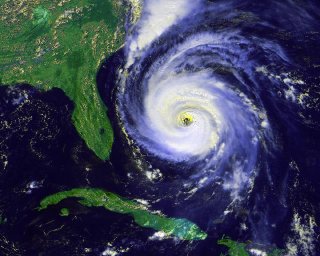“This time of year, keep an eye on the skies!”
 In case you haven’t been paying attention to the news as of late, it’s hurricane season! That means that there are massive tropical cyclones spinning across the globe, leaving large amounts of destruction in their wake. It’s really an awe-inspiring thing. And thank goodness for modern weather forecasting, which has saved many lives by predicting where these storms will go and giving us an idea of how violent these storms will be when they arrive. In the 1950s, the idea of naming storms came into common use, with female names being used for these destructive storms. In 1979, male names were added. It’s how these storms get their names and all that goes into that which really interests me. In the North Atlantic, there are six lists, which rotate every year, with one name for every letter of the alphabet (with the exception of Q, U, X, Y, and Z). If a storm is costly enough in its human toll or in amount of property destruction, the name is often retired. These storms, as they approach land and then make their landfall, become household names. Certainly if I mention the names Charley, Frances, Ivan, or Jeanne, the image of a powerful storm, bringing destruction to the lands it touches, comes to mind. Mention the names Fran (satellite image shown at right) or Isabel to someone living in Virginia, and they can tell you some amazing storm stories. Most interesting about the retirement of storm names, though, is that when a name is “retired”, it actually only bars the name from use for ten years. Technically, “Andrew” is again eligible to be placed on a hurricane list, though I doubt it will ever happen. After the 1992 hurricane season, Andrew was replaced by Alex, which topped the 2004 list of hurricane names. In other parts of the world where hurricanes strike, the storms are known as typhoons, tropical cyclones, willy-willies, severe cyclonic storms, and more. The naming systems for these storms are very different than those used in the western hemisphere. In many naming systems in the eastern hemisphere, several lists are still used, though the naming usually does not start at the top of the list at the beginning of the hurricane season. Borrowing from the Northern Australia name lists, if the last storm of the season is Matt (in the middle of the second list), the first storm of the next season will be Narelle (right after Matt on the list). Fiji uses five lists for storm names. Four lists are used one right after the other (same as other eastern naming systems), and a fifth list is used as a source of replacement names should it become necessary. However, regardless of what we call these storms and how we decide what to name them, these storms are definitely something to treat with respect, as for many of us, our lives and our livelihood could be gone in their winds in a matter of moments.
In case you haven’t been paying attention to the news as of late, it’s hurricane season! That means that there are massive tropical cyclones spinning across the globe, leaving large amounts of destruction in their wake. It’s really an awe-inspiring thing. And thank goodness for modern weather forecasting, which has saved many lives by predicting where these storms will go and giving us an idea of how violent these storms will be when they arrive. In the 1950s, the idea of naming storms came into common use, with female names being used for these destructive storms. In 1979, male names were added. It’s how these storms get their names and all that goes into that which really interests me. In the North Atlantic, there are six lists, which rotate every year, with one name for every letter of the alphabet (with the exception of Q, U, X, Y, and Z). If a storm is costly enough in its human toll or in amount of property destruction, the name is often retired. These storms, as they approach land and then make their landfall, become household names. Certainly if I mention the names Charley, Frances, Ivan, or Jeanne, the image of a powerful storm, bringing destruction to the lands it touches, comes to mind. Mention the names Fran (satellite image shown at right) or Isabel to someone living in Virginia, and they can tell you some amazing storm stories. Most interesting about the retirement of storm names, though, is that when a name is “retired”, it actually only bars the name from use for ten years. Technically, “Andrew” is again eligible to be placed on a hurricane list, though I doubt it will ever happen. After the 1992 hurricane season, Andrew was replaced by Alex, which topped the 2004 list of hurricane names. In other parts of the world where hurricanes strike, the storms are known as typhoons, tropical cyclones, willy-willies, severe cyclonic storms, and more. The naming systems for these storms are very different than those used in the western hemisphere. In many naming systems in the eastern hemisphere, several lists are still used, though the naming usually does not start at the top of the list at the beginning of the hurricane season. Borrowing from the Northern Australia name lists, if the last storm of the season is Matt (in the middle of the second list), the first storm of the next season will be Narelle (right after Matt on the list). Fiji uses five lists for storm names. Four lists are used one right after the other (same as other eastern naming systems), and a fifth list is used as a source of replacement names should it become necessary. However, regardless of what we call these storms and how we decide what to name them, these storms are definitely something to treat with respect, as for many of us, our lives and our livelihood could be gone in their winds in a matter of moments.
Date posted: October 1, 2004
Notes: A great place to read about how hurricanes are named is the storm names page at the National Hurricane Center.








